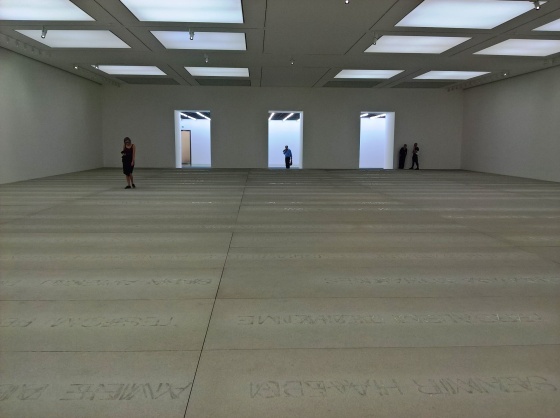



 These intriguing pictures are the work of Colombian artist Doris Salcedo and can be found currently at the White Cube in Bermondsey. I went there last Saturday with my daughter as the review in the Times had been engaging. There are two installations – the Palimpsest, a collection of stone tablets inscribed with the names of people who have died pre-2010 (inscribed in sand) and post-2010 (outlined in water droplets) whilst fleeing North Africa and Turkey to find asylum in Europe – and Tabula Rasa, a meditation on the impact of sexual violence as demonstrated by 5 tables that have been smashed, broken and reassembled painstakingly.
These intriguing pictures are the work of Colombian artist Doris Salcedo and can be found currently at the White Cube in Bermondsey. I went there last Saturday with my daughter as the review in the Times had been engaging. There are two installations – the Palimpsest, a collection of stone tablets inscribed with the names of people who have died pre-2010 (inscribed in sand) and post-2010 (outlined in water droplets) whilst fleeing North Africa and Turkey to find asylum in Europe – and Tabula Rasa, a meditation on the impact of sexual violence as demonstrated by 5 tables that have been smashed, broken and reassembled painstakingly.
Both are quite shocking and technically awe-inspiring. Just trying to understand the technology that enables the droplets of water to seep up through the stone from a filtration system of some sort below, to form the names of those lost, was a challenge. But the Palimpsest was shocking because it completely challenged at the point where the artist intended it to – our unengaged and poorly-rehearsed memory of actual people who fell into the Mediterranean as a result of circumstances few of us can imagine, and then drowned and their bodies lost to the deep, nameless to us, beloved of God who has always known their names and who grieves their loss. The White Cube commentary explains it better:
In her work Salcedo questions and exposes trauma by exploring its capacity to reveal and connect with grief, carving out a space for mourning that is both poignant and insistent. ‘My work is about the memory of experience, which is always vanishing, not about experiences taken from life’, she has said. In Palimpsest, presented in the South Galleries, she deals with the subject of Europe’s migrant crisis and the many who have fled from Africa or the Middle East over the past 20 years and drowned in the Mediterranean or Adriatic attempting to cross into Europe. Produced initially for the Palacio de Cristal, Centro de Arte Museo Reina Sofía in Madrid, the installation consists of a floor of rectangular stone slabs covering the entire gallery space, on which the names of over 300 victims temporarily and intermittently appear. The names are first spelled out in sand (for those who died prior to 2010) and then in delicate droplets of water (for those who died between 2011−16); a constant state of inscription and erasure that transforms the gallery into a potent and active memorial. Bringing to mind the image of a ‘crying’ earth, Palimpsest attempts to expose the inability to collectively mourn, highlighting the way memory functions in a society which is trained to forget, where each new tragedy erases the previous one.
The rise and fall of the definition of the names in water or sand reminds us of the surge of grief-loss and normality that constitute the way most of us come to terms with the loss of those we cared for.
The Tabula Rasa, by contrast, is a recreation of the breakage of humans, principally women, after sexual violence of whatever sort. The commentary states:
…wooden domestic tables subjected to a brutal and complex cycle of destruction and reconstruction, the sculptures suggest how, after such experiences, one can never be whole again since the self will always be changed or ‘lacking’. After being strategically damaged and splintered, each table is painstakingly ‘repaired’, glued back together fragment by fragment over a lengthy period of time. Although at first glance appearing complete and ‘whole’, they remain, in fact, a fragile composite of tiny parts, rebuilt as faithfully as possible in an impossible act of recreation. In some, legs appear aggressively fractured, mended but still not properly registered and full of cracks and gaps, as if they have been worn through or eaten away, while their surfaces reveal a tactile network of fissures, like a map of past damage. Salcedo has described her sculpture as a ‘topology of mourning’. ‘The only possible response I can give in the face of irreparable absence is to produce images capable of conveying incompleteness, lack and emptiness’, she has said.
When we looked carefully at the tables, not only was the craftsmanship astonishing, but the gaps where there were simply bits that had not been recovered or which had been worn away permanently, lent a fragility to the tables. To me also they had the bare presence of tables where unsympathetic officialdom may once have sat, judging, administering pain and destruction in a clerical fashion, like the men who once must have sent thousands to gas chambers or to the gulag.
Salcedo talks of her work as political and mental archaeology – revealing structures beneath the surface of our minds and political systems that can be used to sustain violence in our societies, as well as digging below the surface of victims to reveal experience and then describe it.
Great exhibition – it is free, and on till 11 November.
